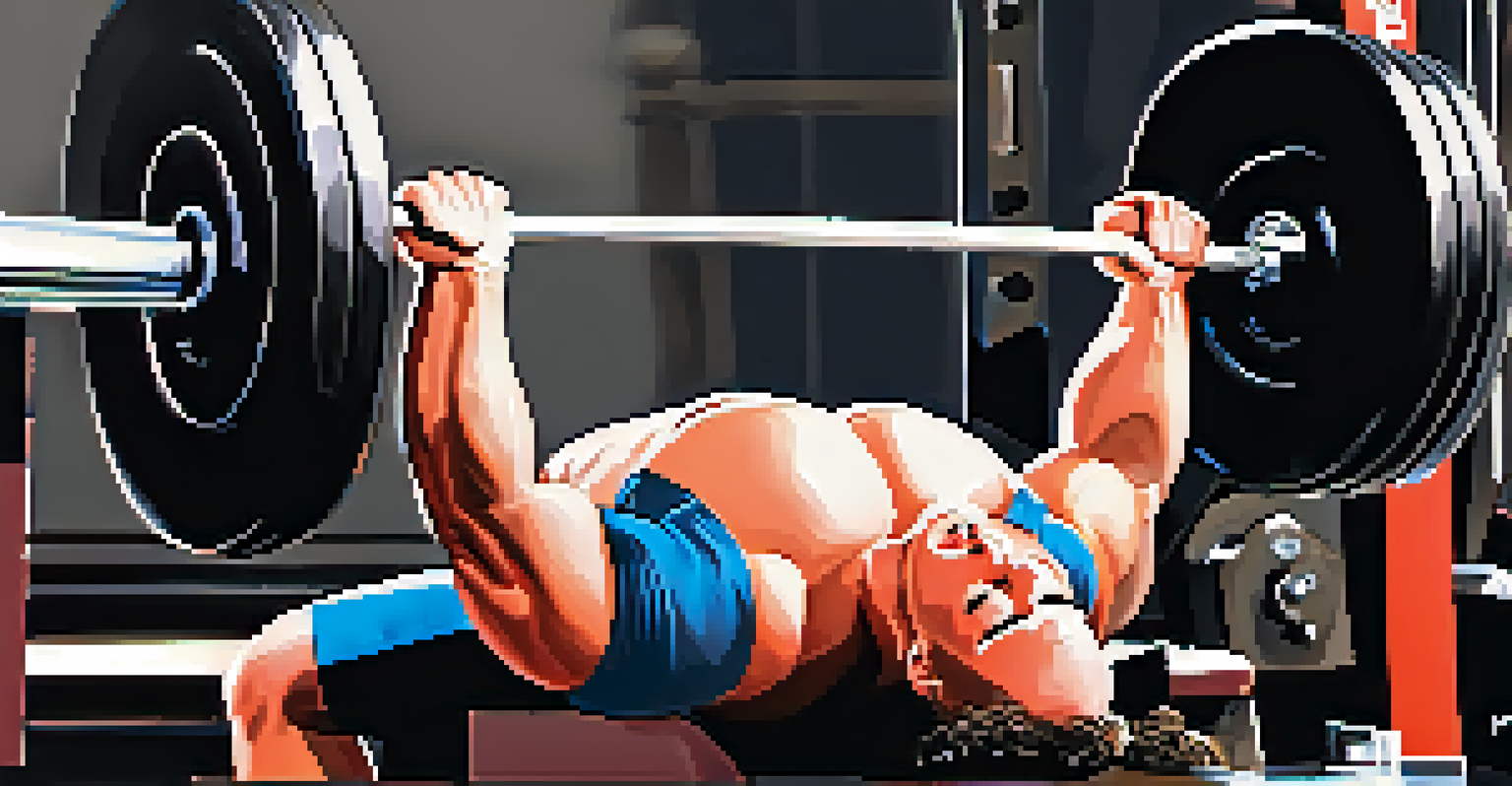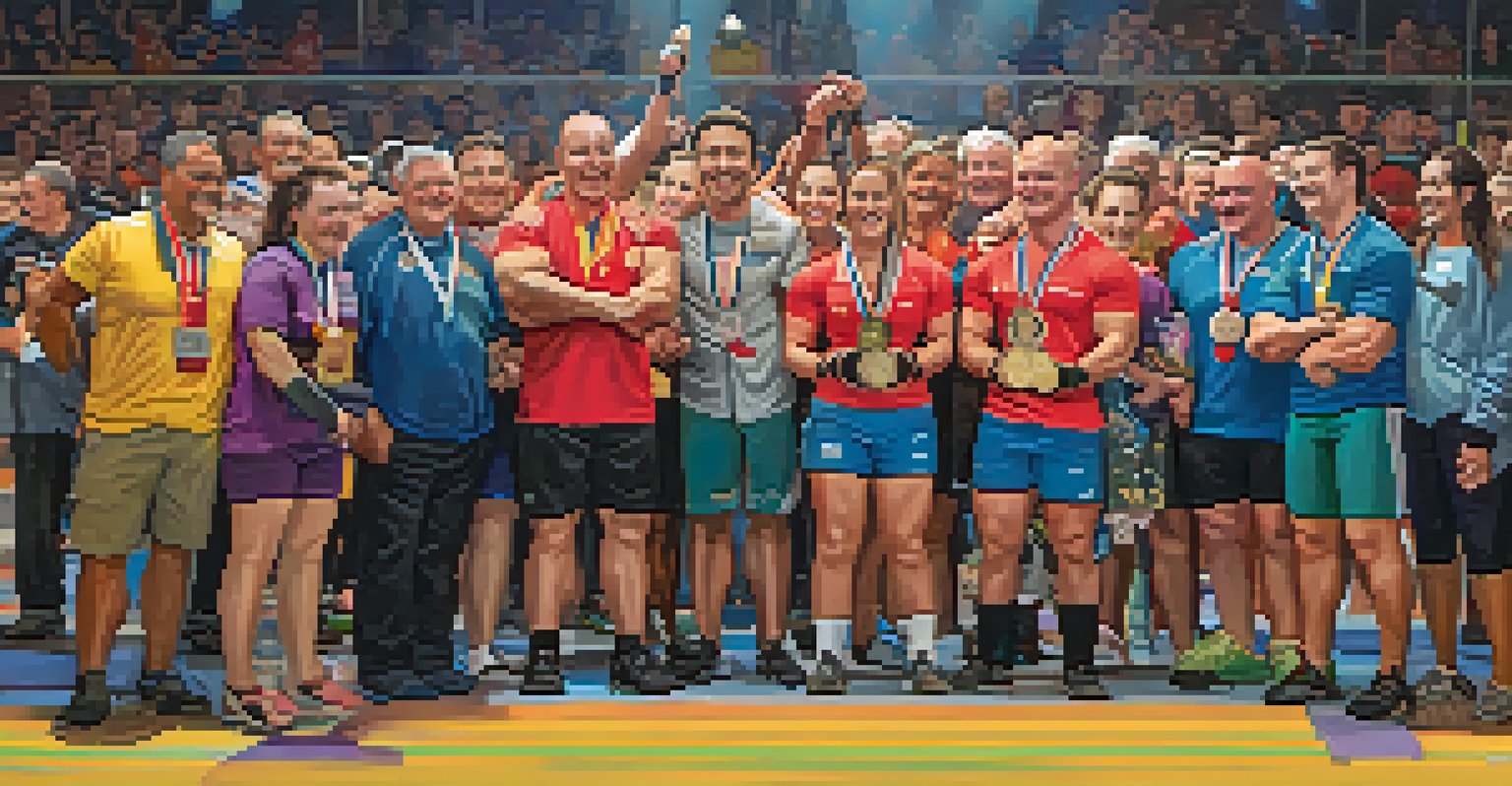Understanding the Powerlifting Competition Format

What is Powerlifting and Its Goals?
Powerlifting is a strength sport that focuses on three primary lifts: the squat, bench press, and deadlift. Each lift tests different muscle groups, making it a comprehensive challenge for athletes. The goal is to lift the maximum weight possible in each of these categories, showcasing sheer strength and technique.
Strength does not come from physical capacity. It comes from an indomitable will.
Unlike bodybuilding, where aesthetics are key, powerlifting emphasizes performance. Athletes compete not just for size but for raw power, which adds a unique intensity to the sport. This focus on lifting heavier weights is what attracts many to powerlifting, as it provides a clear and measurable goal.
Competitors may find themselves drawn to powerlifting for various reasons, whether it's personal achievement, camaraderie, or simply the thrill of pushing physical limits. It’s about building strength and resilience, both physically and mentally.
The Competition Structure Explained
Powerlifting competitions are typically structured in a series of rounds, where each lifter attempts their best lifts in each of the three events. The competition begins with the squat, followed by the bench press, and concludes with the deadlift. Each lifter has three attempts for each lift, allowing them to strategize and optimize their performance.

This structured approach not only keeps the competition organized but also adds an exciting dynamic as athletes can choose to increase their weights based on their previous attempts. The thrill of attempting a new personal record in front of an audience can be both exhilarating and nerve-wracking.
Powerlifting: Strength and Technique
Powerlifting focuses on three key lifts—squat, bench press, and deadlift—emphasizing raw power and technique over aesthetics.
Judges oversee each lift to ensure they meet the required standards, ensuring fairness and adherence to the rules. This aspect of competition emphasizes the importance of technique, as a lift can be disqualified for improper form, regardless of the weight lifted.
Understanding Weight Classes in Powerlifting
Weight classes in powerlifting ensure that lifters compete against others of similar size, promoting fair competition. These classes are divided by weight ranges, meaning that a lighter lifter won’t be competing against someone who weighs significantly more, thus maintaining a level playing field.
The only way to prove you are a good sport is to lose.
Each federation has its own set of weight classes, which can vary slightly, so it’s crucial for competitors to be aware of the specific regulations for their event. This categorization not only allows for fairness but also adds a strategic layer as athletes might aim to compete in a weight class that maximizes their potential.
Understanding where you fit into these weight classes can influence training, nutrition, and overall competition strategy. Many lifters choose to bulk up or cut weight to fit into a desired category, showcasing the sport’s psychological and physical challenges.
The Role of Judges in Powerlifting Competitions
Judges play a pivotal role in powerlifting competitions, as they ensure that each lift adheres to the sport’s strict standards. They evaluate whether the lifter's technique is correct and if the lift meets all criteria for it to be considered valid. This includes checking for depth in squats, proper form in the bench press, and full extension in deadlifts.
Each lift is judged based on specific criteria, and lifters receive either a 'white light' (successful lift) or a 'red light' (failed lift) based on the judges' evaluations. This system of lights adds an element of suspense, as athletes and the audience await the verdict after each lift.
Fair Competition with Weight Classes
Weight classes in powerlifting ensure that lifters compete against others of similar size, promoting fairness and strategy in competition.
Judges are typically experienced lifters themselves and are trained to maintain impartiality. Their expertise not only upholds the integrity of the competition but also provides valuable insights for lifters looking to improve their technique and performance.
Warm-Up and Preparation for Competitors
Preparation for a powerlifting competition involves much more than just lifting weights. Athletes must engage in a structured warm-up routine to prepare their bodies for the physical demands of the competition. This often includes lighter sets of each lift to ensure muscles are activated and ready to go.
The mental aspect of preparation is equally crucial. Athletes often visualize their lifts, set goals for each attempt, and develop strategies to optimize performance. This mental rehearsal can boost confidence and help reduce anxiety during the actual competition.
Additionally, competitors must consider nutrition and hydration leading up to their lifts. Proper fueling can significantly impact energy levels, making it essential for athletes to plan their meals and hydration strategies carefully before the big day.
Scoring and Determining the Winner
The scoring in powerlifting competitions is based on the total weight lifted across all three lifts. Each lifter's best successful attempt in each category is added together to calculate their total score. This straightforward system allows for easy comparison among competitors and determines the ranking.
In some competitions, lifters may also be ranked based on the Wilks score, which adjusts the total weight lifted based on body weight, allowing for a fair comparison across different weight classes. This adds an exciting layer to the competition, as it acknowledges the relative strength of each athlete.
Judges Ensure Fairness and Integrity
Judges play a crucial role in evaluating lifts based on strict criteria, maintaining the integrity of competitions and providing valuable feedback to athletes.
Ultimately, the lifter with the highest total weight or the best Wilks score in their category is crowned the champion. This simplicity in scoring, coupled with the thrill of competition, is what makes powerlifting an engaging sport for both participants and spectators.
Post-Competition: Recovery and Reflection
After the adrenaline of competition fades, the focus shifts to recovery and reflection. Athletes often experience fatigue and soreness after pushing their bodies to the limit, so proper recovery techniques, such as stretching, hydration, and nutrition, are essential.
Many lifters take time to analyze their performance, reviewing what went well and what could be improved for future competitions. This reflective process is crucial for growth, as it allows athletes to adjust their training and strategies based on their experiences.

Post-competition also offers an opportunity for camaraderie among lifters. Sharing experiences, celebrating successes, and discussing challenges helps build a sense of community within the sport, reinforcing the idea that powerlifting is not just about individual achievements, but also about supporting one another in the journey.